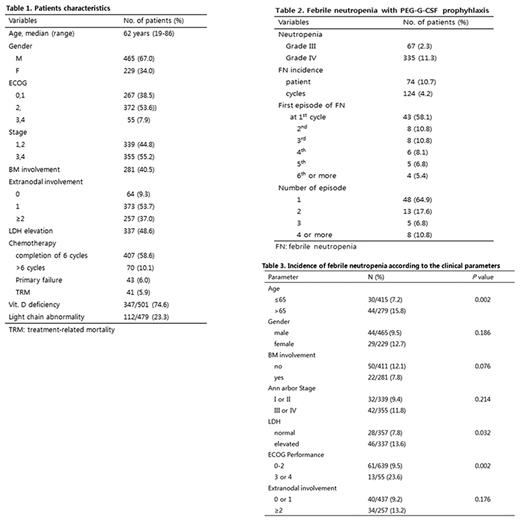Abstract
Background
Febrile neutropenia (FN) is the most important side effect of chemotherapy in diffuse large B cell lymphoma (DLBCL) causing not only treatment-related morbidity but also suboptimal chemotherapy delivery. Prophylactic use of granulocyte colony stimulating factor (G-CSF) or pegylated G-CSF (PEG-G-CSF) is known to reduce the incidence of both neutropenia and FN. We conducted a prospective registry study to evaluate prophylactic effect of PEG-G-CSF in DLBCL patients treated with R-CHOP regimen (ClinicalTrials.gov Identifier: NCT02474550).
Patients and Method
Since January 1st 2015, after written informed consent, patients receiving R-CHOP therapy with curative intent were registered and prospectively monitored. All patients were pathologically confirmed with DLBCL according to World Health Organization Classification 2008. Prophylactic Peg-G-CSF was given 24 hours after R-CHOP chemotherapy subcutaneously. The incidence of neutropenia and neutropenic fever were studied. Febrile neutropenia (FN) is defined as an oral temperature >38.5°C or two consecutive readings of >38.0°C for 2h and an absolute neutrophil count <0.5 × 109/l, or expected to fall below 0.5 × 109/l. This interim-analysis was performed as of 1st June 2017.
Results
A total of 2957 cycles in 694 patients were included in the analysis. Base-line characteristics are summarized in Table 1. Median age at diagnosis was 62 (10-86) with a predominance of males (67%). Most patients had extranodal involvement (90.7%) and 257 patients (37%) had two or more extra-nodal involvements. The most common extranodal involvement sites were stomach (16.6%), bone (11.7%), intestine (11.4%) and lung (8.8%). Bone marrow involvement was observed in 281 patients (40.5%). At the time of analysis 407 (58.6%) patients completed 6 cycles of R-CHOP therapy. Forty-three patients (6%) experienced primary failure with R-CHOP treatment. Treatment related mortality occurred in 41 patients (5.9%). Grade III/IV neutropenia was developed with the incidence of 13.6% (402/2957 cycles) in the patients. FN developed in 74 (10.7%) patients with the overall incidence of 4.2% (124/2957) in the cycles (Table 2.). Twenty-five patients (33.7%) had multiple episodes of FN. Most patients (78.9%) experienced the first episode of FN within three cycles. Among pretreatment clinical factors analyzed, age, ECOG performance status and LDH level were related with the development of FN (Table 3.). Vitamin D deficiency at diagnosis was observed in 74.6% (347/501) of the patients but not associated with the development of FN. Deranged Light chain level is detected in 23.3% (112/479) of the patients, but not associated with the development of FN as well.
Conclusion
This interim analysis showed clinical feature of FN with PEG-G-CSF prophylaxis in DLBCL patients. Peg-G-CSF prophylaxis was effective in reducing the incidence of neutropenia and FN. However, the patients who were elderly, with poor performance status or high LDH level still had high incidence of FN. We will further study whether this result could be translated into better treatment outcomes in the patients.
Kim: Celltrion, Inc: Consultancy, Honoraria; Takeda: Research Funding; Kyowa-Kirin: Research Funding; J&J: Research Funding; Novartis: Research Funding; Donga: Research Funding; Mundipharma: Research Funding; Roche: Research Funding.
Author notes
Asterisk with author names denotes non-ASH members.


This feature is available to Subscribers Only
Sign In or Create an Account Close Modal